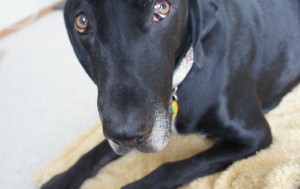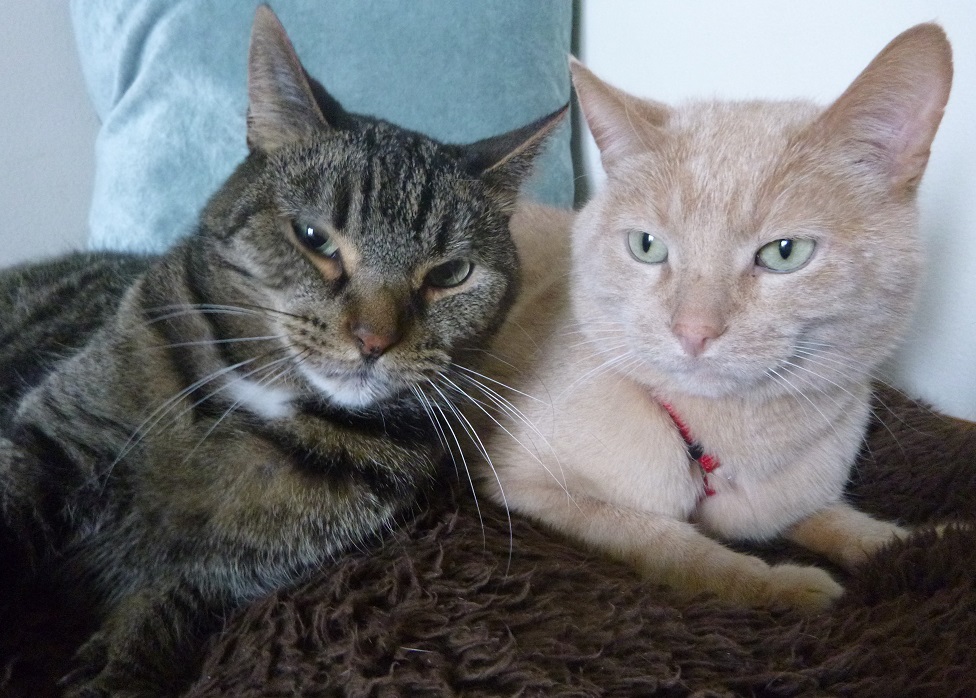My mutt Ace knows the names for our two cats.
OK, I’m not sure if he recognizes the words “Beamer” and “Scout” as names to represent the cats or if he recognizes the words as commands to look at either cat, touch either cat with his nose or chase either cat. He seems to interpret their names as commands. “Scout” seems to mean “find Scout” or “look at Scout” or “touch Scout.”
It’s also hard to tell if Ace recognizes the correct name (or command) for each cat.
It seems like he is able to differentiate correctly about 75 percent of the time. This is most likely because he picks up on cues from me. Which cat am I looking at? Which cat is my body facing? And of course, which cat is closest to us?
I thought I’d make an attempt to actually teach my dog the names of our two cats.
How to teach a dog the names of your family members
I am focusing on teaching my dog the names of my cats. The same method could be used for teaching a dog the names of people (or other dogs).
The short version:
Start with one family member. Have your dog sitting close to you with the family member sitting or standing nearby. Say something like, “Where’s Scout?” If the dog even so much as glances at the correct person (or cat), mark the behavior with “Good!” and instantly give a treat. From there, slowly progress by rewarding the dog for holding his glance a bit longer. Don’t progress too quickly, and don’t teach additional names until the dog seems to know the first.
 The details:
The details:
Choose a consistent command.
The commands I’m using are “Where’s Scout?” and “Where’s Beamer?” Eventually, I would like my dog to be able to seek out and “find” each cat.
Decide specifically what you want your dog to do.
What specific behavior do you want your dog to do? Look at the correct person? Touch the person with his nose? Gently put a paw on the person? Sit in front of the person? It’s up to you to teach your dog the behavior you want.
I’ve decided I want Ace to sit in front of the correct cat and look at the cat with no physical contact. This will take lots of practice and self-control for Ace because he loves to “nose bump” the cats. He’s gentle when he does this, but I’d rather train him out of it.
Break the behavior into simple steps.
I want to teach my dog to sit in front of the correct cat while looking at the cat, but I can’t expect him to do this right away. First, I have to reward him for even glancing at the cat. Next, I’ll reward him for holding that glance for a second or two. Then five seconds. Then maybe I’ll add the sit portion. With time, I hope to be able to add distance so Ace will walk across the room and sit in front of the cat. After that, I hope to train him to use his nose to actually seek out and find the cat from anywhere in the house.
Mark the correct action and reward!
I need to reward Ace the instant he looks at the correct cat. If he so much as glances at Scout I say “Good!” and give a treat. A clicker would work well for this. I’m just not much of a clicker trainer.
Practice many reps in short sessions.
Each dog is different, but you want your dog to enjoy the training. Usually it’s best to practice the command multiple times in a row but only for five minutes or so. Lots of short sessions are generally better than one longer session.
Teach one name at a time.
I can’t confuse Ace by working on more than one name at a time. For now, I am teaching him “Where’s Scout?” Once he has that down, I will work on “Where’s Beamer?” Then I will practice with both cats in the room, but I will only ask him about one of the cats per session.
You may need to lure your dog at first.
Your dog might not understand what you want him to do at first. This is why you should start with just one family member and have that person standing or sitting really close. It’s only a matter of time before the dog naturally glances at the correct person. That’s why you need to mark – “Good!” – and reward.
If your dog does not glance at the correct person even after a minutes or so, you can try pointing or luring him in the right direction. Just try to stop doing this as soon as you can because you don’t want your dog to learn to wait for the physical cue from you. When he looks at the person without a physical cue from you, make sure to go overboard with praise! “Wow, what a good boy!”
What about you? How have you taught your dog the names of different family members?
Don’t they just look thrilled? 🙂



Cassidy
Saturday 21st of May 2022
When I was little (5 or 6) my grandma had a miniature poodle who knew the names and I guess scents of her grandchildren There were 4 of us at the time. We would hide all around the house and my grandma would tell him WHICH child to find and he would find the correct child. I don't know how she trained him to do that.
Beth Scott
Thursday 7th of March 2013
Interestingly enough, I really never taught my dog the names of our family members in a formal way, but somehow he picked up on it. His names for my husband and I are "mom" and "dad." If I ask him where "dad" is?, he instantly goes and seeks out my husband. I think it was just a repetition of that game. He also knows the names of my sister, her husband, and my daughter. Again, I never really formally taught him their names, he just knows. Dogs are so much smarter than we think! I believe he just picked up their names from the cues we gave him, on a very informal basis. I have other examples of things that I did not really "formally" train him, but he knows. For example, when I take him out to play frisbee, when I am done, I point to the house and say, "come on, in the house." He automatically goes up on the porch and waits for me to meet him and open the door to go into the house - again, no real formal training, he just picked it up. The ways that dogs learn always amaze me!!
Beth
Pipa
Thursday 7th of March 2013
That is so true Beth, my dog does the same - like "let's go play" and "inside/outside" are all just things my dog eventually associated with the appropriate command. They're very clever indeed!
Lindsay Stordahl
Thursday 7th of March 2013
I'm sure they know a lot more than we realize!
Pipa
Wednesday 6th of March 2013
Our dog "knows" me and my partner's names, although we are "mummy" and "daddy" (laaame I know haha!). "Where's daddy/mummy?" means to go to that person (and is often used when we're trying to distract him from something else when out!). Also, after my partner and I get home, whoever Jasper says hi to first will say, "now go say hi to Mummy/Daddy" and he'll come over to the other person. Whether or not he knows our 'names' or this is just ritual I don't know though!
Lindsay Stordahl
Thursday 7th of March 2013
Cute! :)
Leila
Wednesday 6th of March 2013
I love this! Its seems like a fun thing to teach a dog :)
Dawn
Wednesday 6th of March 2013
Fun! I can see how this could come in handy. It sort of sounds a little like how you would train a search and rescue dog, except they find by scent rather than by name.